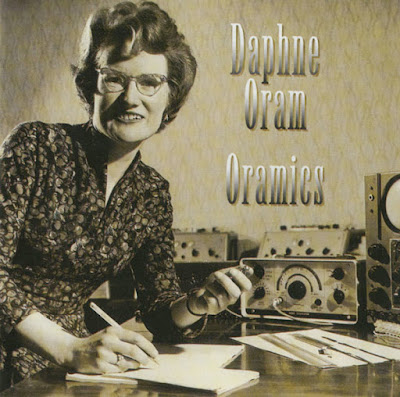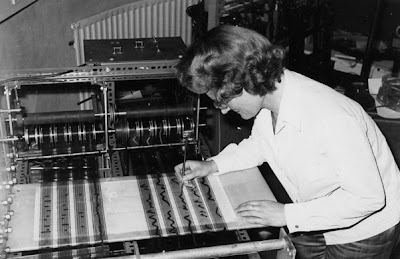

keepin it reel to reel

paintin on film

oramics machine

knob twiddlin with petey sellers
Daphne Oram [1925 – 2003] was a pioneering British composer & electronic musician. The first woman to create & run a sound studio & subsequently design & build an entirely new sound recording medium, she created the 'Oramics' technique at the BBC Radiophonic Workshop in England. This method of musique composition & performance was intended by Oram to allow a composer to be able to draw an 'alphabet of symbols' onto a set of ten sprocketed synchronised strips of 35mm film which covered a series of photo-electric cells that in turn generated an electrical charge to control the sound frequency, timbre, amplitude & duration & feed it through a machine that would, in turn, produce the relevant sounds on magnetic tape. The output from the instrument was only monophonic relying on multitrack tape recording to build up polyphonic textures.
Educated at Sherborne School For Girls, Oram was, from an early age, taught piano & organ as well as musical composition. In 1942 she was offered a place at the Royal College of Music but instead took up a position as a Junior Studio Engineer and 'musique balancer' at the BBC. During this period she became aware of developments in "synthetic" sound and began experimenting with tape recorders. She also spent some time in the 1940s composing music, which remained unperformed, including an orchestal work entitled Still Point. In the 1950s she was promoted to become a music studio manager and, following a trip to the RTF studios in Paris, began to campaign for the BBC to provide electronic music facilities for composing sounds and music, using electronic music and musique concrète techniques, for use in its programming. In 1957 she was commissioned to compose music for the play Amphitryon 38. Using a sine wave oscillator, an early tape recorder & some self-designed filters, she produced the score from only electronic sources; the first of its kind at the BBC. Along with fellow electronic musician and BBC colleague Desmond Briscoe, she began to receive commissions for many other works - including a significant production of Samuel Beckett’s All That Fall. As demand grew for these electronic sounds, the BBC gave Oram and Briscoe a budget to establish the BBC Radiophonic Workshop in early 1958, where she was the first Studio Manager.In October of that year, she was sent by the BBC to the "Journées Internationales de Musique Expérimentale" at the Brussels World’s Fair [where Edgard Varèse demonstrated his Poème électronique]. After hearing some of the work produced by her contemporaries and being unhappy at the BBC's music department's lack of interest, she decided to resign from the BBC less than one year after the workshop was opened, hoping to develop her techniques further on her own.
In 1959 she installed her Oramics Studios for Electronic Composition in Tower Folly, a converted oast house at Fairseat, near Wrotham, Kent. Her output from the studio, mostly commercial, covered a far wider range than the Radiophonic Workshop, providing background music for not only radio and television but also theatre and short commercial films. She was also commissioned to provide sounds for installations and exhibitions. Other work from this studio included electronic sounds for Jack Clayton's 1961 horror film The Innocents, concert works including Four Aspects and collaborations with opera composer Thea Musgrave and Ivor Walsworth
In February 1962, she was awarded a grant of £3500 from the Gulbenkian Foundation to support the developments and research of her "Oramics" drawn sound technique. A second Gulbenkian grant of £1000, awarded in 1965, enabled the Oramics composition machine to be completed. The first drawn sound composition using the machine, entitled 'Contrasts Essonic' was recorded in 1968
Throughout her career she lectured on electronic music and studio techniques. In 1971 she wrote An Individual Note of Music, Sound and Electronics which investigated electronic music in a philosophical manner. Besides being a musical innovator her other significant achievements include being the first woman to direct an electronic music studio, the first woman to set up a personal studio and the first woman to design and construct an electronic musical instrument
In the 1990s she suffered two strokes and was forced to stop working, later moving to a nursing home. She died in 2003, aged 77. r.i.p. Daphne Oram 1925-2003. further
dubble disque set from this amazing human being. i think she raised goats too. what a babe. it should be noted that in the first trauqe, 'introduction', her voice gets slightly truncated toward the end. they probably could have done a fade-out or something but this is exactly how the original release sounds, so please don't let it discourage you from hearing the remainder of these compositions. 320 thanks to espilos.
No comments:
Post a Comment